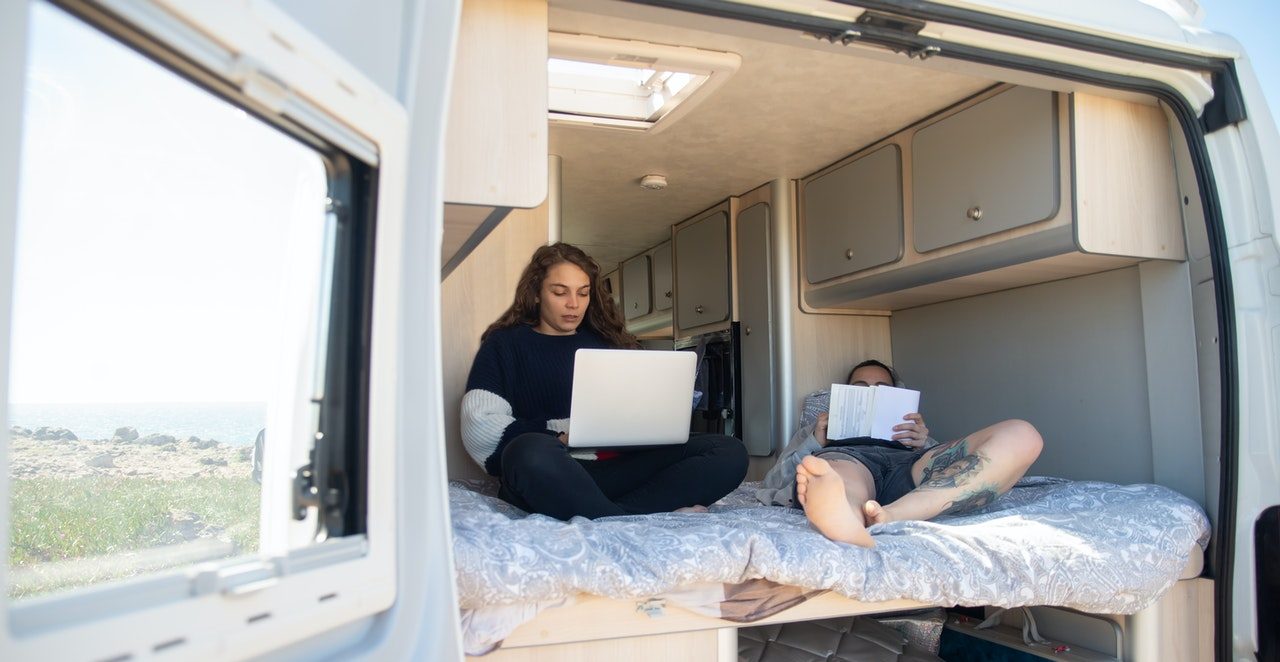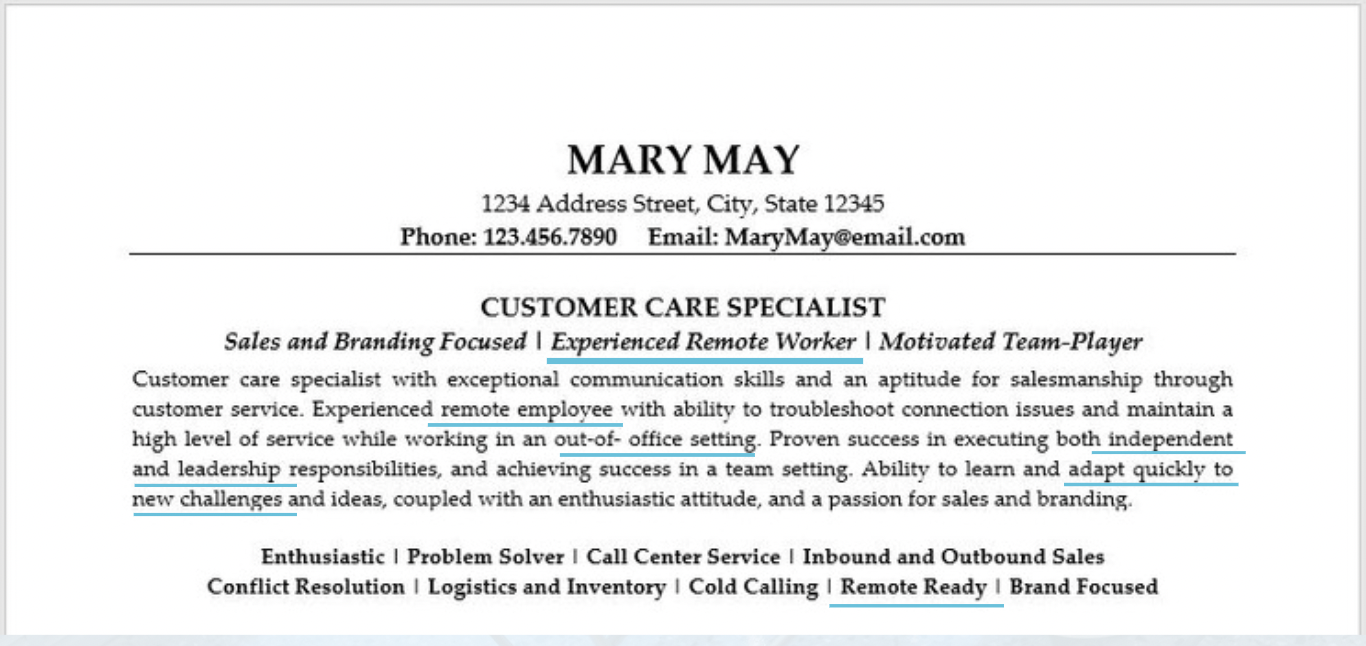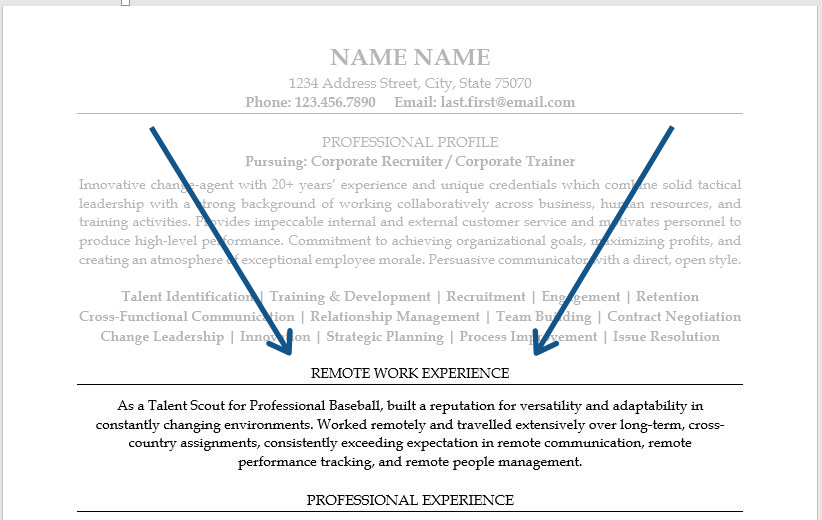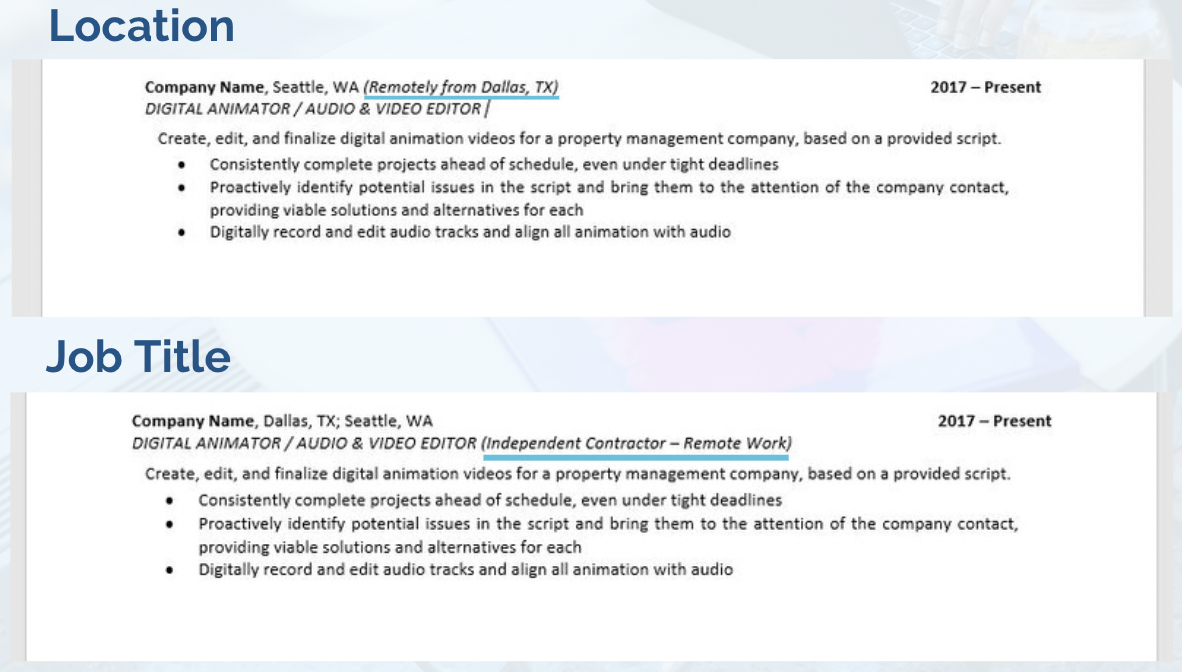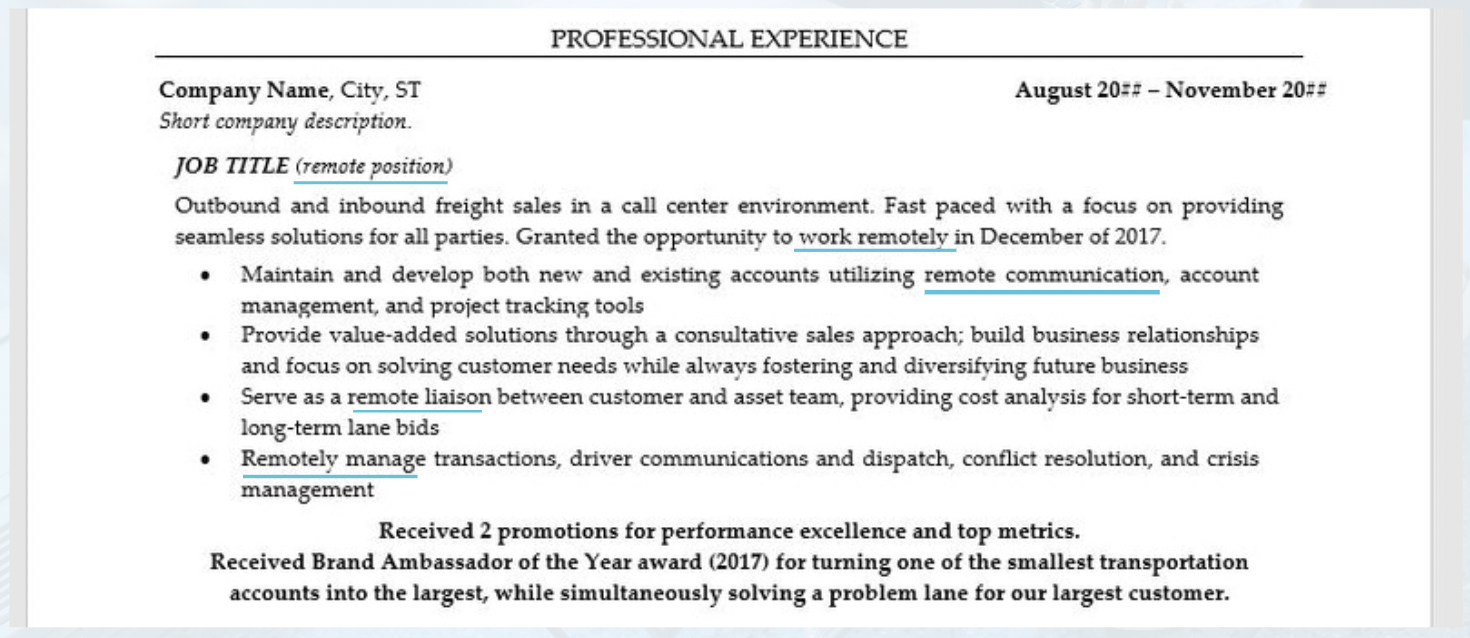How to Position Yourself for Remote Work Jobs was originally published as How to Find Remote Work (and position yourself for remote jobs) on ResumeLezlie.com.
It’s no secret that remote work has been suddenly thrust to the forefront since COVID-19 hit in early 2020, and it looks like it’s going to have lasting effects.
Statistics show that workers want remote work options to stick around for the future.
One survey from Owl Labs (highlighted by Apollo Technical) showed:
- After COVID-19 92% of people surveyed expect to work from home at least 1 day per week and 80% expected to work at least 3 days from home per week.
- 23% of those surveyed would take a 10% pay cut to work from home permanently.
- 59% of respondents said they would be more likely to choose an employer who offered remote work compared to those who didn’t.
And that’s probably because workers are finding a lot of benefits from working remotely, including:
- Remote employees save an average of 40 minutes daily from commuting.
- People are saving on average close to 500 dollars per month being at home during COVID-19. Resulting in savings close to $6000 per year.
- Workers who were working at home reported being happy 22% more than workers who always work in an onsite office environment.
Another survey from Ivanti and recently showcased by Forbes showed:
- 87% of survey respondents do not want to work from the office full-time
- 45% would be happy to never step foot in an office again
- 71% stated that they would choose to be able to work from anywhere (WFA) over a job promotion or compensation increase
If you’re thinking of making the shift to remote work, this blog will help.
Finding Remote Work
Before we get into positioning yourself for remote roles, let me quickly give you a rundown of a few great places to find remote work.
First, let me just say that job boards should not be your only source of finding roles, remote or otherwise. It’s always best to incorporate strong networking into your job search strategy using LinkedIn and other networking platforms.
To learn more about those tactics and strategies, click the two links above. Seriously – they’re important.
For the purposes of this blog, we’re going to move on to some of the top remote work job boards.
It’s important to note that you can usually filter for remote roles or add the word ‘remote’ to your search on the most popular job boards, including LinkedIn, Indeed, ZipRecruiter, SimplyHired, Monster, etc.
To help you conduct an even more targeted search, I’ve listed below some of the best remote-specific job boards.
The top job board for RVers is Escapees’ and Xscapers’ own RVer Job Exchange.
Created for RVers and employers who fuel the RV lifestyle, this job board is new, quickly growing, and focused on fully-remote roles that can be done from anywhere.
Other remote work job boards include Crossover.com, DynamiteJobs.com, FlexJobs.com, Talent.Hubstaff.com, VirtualVocations.com, WeWorkRemotely.com, and WorkingNomads.co.
Remote Work Lingo
Below I’ve listed 25 terms for working remotely than can help you (1) search for the right types of roles for you, and (2) describe any remote or remote-related work you’ve done so far in your career. (Detailed more in the next section)
25 Terms for Working Remotely
- Remote work
- Remote job
- Virtual work
- Virtual job
- At-home job
- Work-at-home
- Work-from-home
- Home-based office
- Telecommute
- Telework
- Location agnostic
- Location independent
- Distributed workforce
- Geographically neutral
- Online jobs
- Results-Only Work Environment (ROWE)
- Distance work
- Off-site work
- Open location
- Home-shored
- Digital nomad
- Mobile professional
- Road warrior
- Location independent
- Digital workplace
Showcasing Remote Work Skills
Remote work skills differ from traditional skills in a few key ways. But a lot of experience and skills developed through traditional roles can be translated to demonstrate value in a remote work setting.
It’s important to rethink your job descriptions and translate them into language that better suits remote work roles.
Remote work is still new(ish) in the workforce, and a lot of candidates aren’t leveraging the skills they have.
This means that if you *can* demonstrate your value as it relates directly to remote work, you’ll be able to elevate yourself above your competition.
Do research on online job boards to understand how remote work skills can be incorporated into your job descriptions.
Ask yourself things like:
- When did I use these skills in my previous jobs?
- What tasks could be creatively described using these keywords?
Think about times when you worked with or managed teams remotely – even if it wasn’t technically in a ‘remote work’ role.
- If you managed teams or individuals in other offices or worksites – that’s working remotely.
- If you reported to leadership that was often offsite – that’s working remotely.
- If you transitioned to Zoom meetings during COVID – that’s working remotely.
It’s also important to take inventory to identify potential skills gaps that you may need to address through additional experience or training. Be honest in this exercise so you can proactively prepare for the transition into remote work.
Below are some important Remote Work Skills & Keywords you can use to communicate your value for remote work roles:
- Adaptability
- Cross-locational
- Experienced remote worker
- Out-of-office setting
- Remote communication
- Remote employee
- Remote leadership
- Remote liaison
- Remote people management
- Remote performance tracking
- Remote ready
- Remotely manage
- Versatility
- Work remotely
To help you better understand how to communicate these skills, below I’ve included some examples.
Examples of Communicating Your Remote Experience & Skills
Profile:
Remote Work Section:
Location or Job Title:
Job Description:
Remote Work Technology
Familiarizing yourself with remote work tools and technology
Many of the most popular software options out there offer free trials, so get in there and look around, understand what they do, how they work, and what benefits they provide.
Some of the most popular are listed below:
Calendar
- Google Calendar- cloud-based, vast integration with other apps
- Any.do- schedules, tasks, goals, reminders (works well on mobile)
- Monday.com- team scheduling software with visual tracking
- Square Appointments- online booking and scheduling
- Calendly- booking and scheduling software
- 24me- manages all calendars, connects to social media, syncs with other calendars
File sharing platforms
- Google Drive- free file storage and synchronization tool
- HelloSign- create, share and store documents and signatures
- DropBox- file storage and sharing, best for speed and security
- OneDrive- file storage and sharing, integrates well with Microsoft
Video conferencing & enterprise communication
- Slack- chat app, real-time communication with colleagues
- Workplace (by facebook)- messaging, voice/video calling, like a FB group for work
- Google Hangouts- video meeting, 3+ people communicating together at the same time
- Flowdock – real-time team chat
- Zoom- cloud-based video, audio and chat conferencing tool
- Skype- voice/video chat, can share screen
- Join.me- team/private video, can share screen
Task / Project Management
- Project Tracking
- Asana- manage, track and assign tasks, monitor progress
- Basecamp- task mgmt., messaging and collaboration, file sharing, scheduling
- Hubstaff Tasks- assign tasks, create checklists, create smooth workflow
- Todoist- tracks projects in lists/sub-lists
- Team management
- Trello- individual task organization and internal project mgmt
- 1Password- all passwords in one place for whole team
- IDoneThis- keeps teams in-sync
- Time tracking
- Hubstaff- time tracking and work management app
- Time Doctor- time management tool
- Harvest- time and expense tracking
Video Interviewing (1-way and 2-way)
- VidCruiter- suite of tools for pre-recorded video, live video, and scheduling
- Spark Hire- 1-way and live video
- Interviewstream- live video interviewing
- eSkill- voice and video interviewing, skills and behavior tests
- EasyHire- cloud-based, on-demand and live video, skill assessments, interview analytics, collaboration
- Breezy HR- schedule and record video interviews
Phone & Video Interviews
First, a few quick tips for phone and video interviews.
Get the Details
Don’t be afraid to ask the recruiter, interviewer, or whoever is the point of contact the specifics of the platform, what you’ll need for the interview, and who you’ll be interviewing with.
Have your resume ready
The interviewer will undoubtedly ask questions about your career history, so having your resume in front of you can help keep you on track.
Prepare a cheat sheet
This should include highlights of the research you did about the company and the job, as well as any of your own career highlights and any questions you have.
There are 2 different types of video interviews: one-way and two-way.
Two-Way interviews are where you interact directly with a recruiter or hiring manager in real time through web conferencing software like Skype, Facetime, Google Hangouts, etc. This will usually come into play for 2nd or 3rd round interviews, after you’ve passed initial screening.
One-Way interviews are usually used earlier in the interview process. For these, you record yourself answering pre-scripted questions, there are often specific instructions and/or time constraints.
Many of the logistics for video interviews are similar to in-person interviews, but there are some differences. I’ve listed several categories below.
Wardrobe
This makes up a large part of your first impression. You should based your wardrobe decisions on the type of job, career level, and company. Be aware of your background and be sure to coordinate what you’re wearing based on your background.
Location & Background
Whenever possible, conduct your interview in a private space where you can control all (or at least most of) the environmental factors. Ditch any distractions in your background – this means removing anything that adds clutter or any items that could be considered controversial.
Lighting
Good lighting is critical. If possible, face a window for natural light. If there are items behind you or you’re sitting in front of a wall, try to sit a few feet in front of those things to eliminate shadow. If that’s not possible, good backlighting can help eliminate shadows behind you.
Audio & Camera
Be sure to download and practice with all of your tech beforehand. Check your camera positioning and angle. Pro tip: positioning the camera slightly above your eye level is often an attractive angle for the subject (you).
Additional Tips
• Try to stay still, but comfortable – it’s okay to use hands a little (but not too much!)
• Look at the eye of the camera, not at the screen
• A sticker or sticky-note can help you remember where to look
• Sticky notes around screen to help you remember questions you want to ask or other important information
For more remote work tips slow-dripped into your social feeds, follow me on Facebook and LinkedIn!



